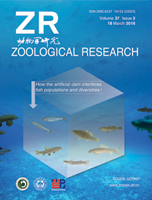
|
Zoological Research
Kunming Institute of Zoology, Chinese Academy of Sciences
ISSN: 2095-8137
Vol. 38, No. 3, 2017, pp. 163-170
|
 Bioline Code: zr17021
Bioline Code: zr17021
Full paper language: English
Document type: Research Article
Document available free of charge
|
|
|
Zoological Research, Vol. 38, No. 3, 2017, pp. 163-170
| zh |
EP300基因通过调控一氧化氮合成帮助藏族人群适应高原低氧环境
Zheng, Wang-Shan; He, Yao-Xi; Cui, Chao-Ying; Ouzhuluobu; Dejiquzong; Peng, Yi; Bai, Cai-Juan; Duojizhuoma; Gonggalanzi; Bianba; Baimakangzhuo; Pan, Yong-Yue; Qula; Kangmin; Cirenyangji; Baimayangji; Guo, Wei; Yangla; Zhang, Hui; Zhang, Xiao-Ming; Guo, Yong-Bo; Xu, Shu-Hua; Chen, Hua; Zhao, Sheng-Guo; Cai, Yuan; Liu, Shi-Ming; Wu, Tian-Yi; Qi, Xue-Bin & Su, Bing
藏族人群经过长期的自然选择在遗传上对高原低氧环境产生了良好的适应。以前的研究表明藏族人群对低氧的适应是多个基因参与的过程。本研究为了检测低氧适应候选基因-组氨酸乙酰化酶(EP300)对藏族高原适应的作用,对80个无亲缘关系的藏族个体EP300基因80.89kb及其上下游各10kb非编码区域进行了重测序。结合之前发表的数据,我们采用基于等位基因频率和单倍型的方法对选择信号进行检测,并做了功能预测和eQTL等分析。研究结果显示,藏族人群与平原人群(汉族、欧洲人群和非洲人群)相比有多个EP300多态位点表现出等位基因频率的明显分歧,受到了达尔文正选择的作用。此外,我们对226个无亲缘关系的藏族个体进行了遗传相关性分析,结果显示EP300与藏族血液中一氧化氮(NO)含量显著相关,提示EP300可能通过调节一氧化氮(NO)的水平帮助藏族人群适应高原低氧环境。
藏族; 低氧适应; EP300; 遗传适应; 一氧化氮
|
| |
| en |
EP300 contributes to high-altitude adaptation in Tibetans by regulating nitric oxide production
Zheng, Wang-Shan; He, Yao-Xi; Cui, Chao-Ying; Ouzhuluobu; Dejiquzong; Peng, Yi; Bai, Cai-Juan; Duojizhuoma; Gonggalanzi; Bianba; Baimakangzhuo; Pan, Yong-Yue; Qula; Kangmin; Cirenyangji; Baimayangji; Guo, Wei; Yangla; Zhang, Hui; Zhang, Xiao-Ming; Guo, Yong-Bo; Xu, Shu-Hua; Chen, Hua; Zhao, Sheng-Guo; Cai, Yuan; Liu, Shi-Ming; Wu, Tian-Yi; Qi, Xue-Bin & Su, Bing
Abstract
The genetic adaptation of Tibetans to high altitude hypoxia likely involves a group of genes in the hypoxic pathway, as suggested by earlier studies. To test the adaptive role of the previously reported candidate gene EP300 (histone acetyltransferase p300), we conducted resequencing of a 108.9 kb gene region of EP300 in 80 unrelated Tibetans. The allele-frequency and haplotype-based neutrality tests detected signals of positive Darwinian selection on EP300 in Tibetans, with a group of variants showing allelic divergence between Tibetans and lowland reference populations, including Han Chinese, Europeans, and Africans. Functional prediction suggested the involvement of multiple EP300 variants in gene expression regulation. More importantly, genetic association tests in 226 Tibetans indicated significant correlation of the adaptive EP300 variants with blood nitric oxide (NO) concentration. Collectively, we propose that EP300 harbors adaptive variants in Tibetans, which might contribute to high-altitude adaptation through regulating NO production.
Keywords
Tibetans; High altitude; Hypoxia; EP300; Genetic adaptation; Nitric oxide
|
| |
© Copyright 2017 - Editorial Office of ZOOLOGICAL RESEARCH
Alternative site location: http://www.zoores.ac.cn/
|
|
